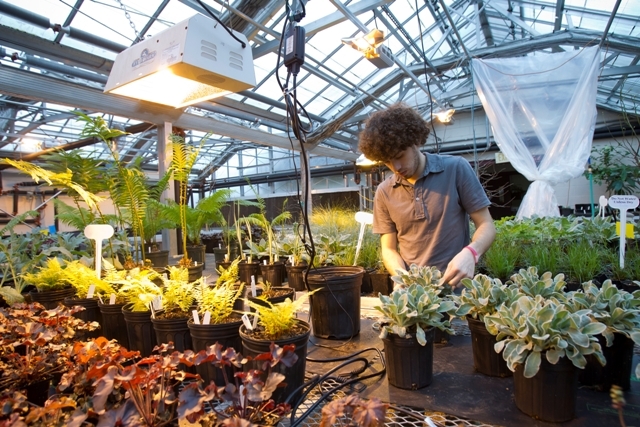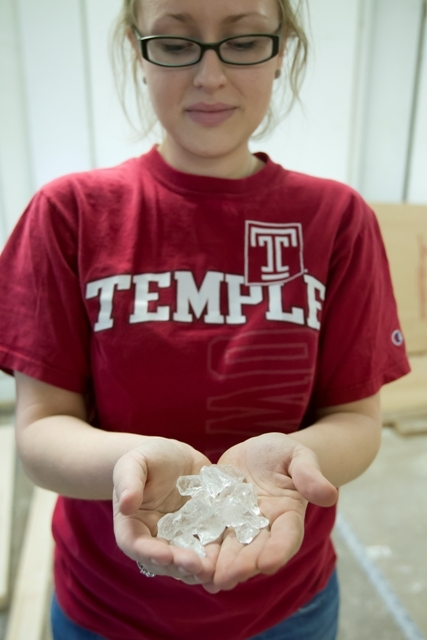Student exhibitors ready for ‘wilde’ ride at annual flower show
Students and faculty in Temple Ambler’s Department of Landscape Architecture and Horticulture are taking a walk on the “wilde” side in preparation for their 2013 Philadelphia Flower Show exhibit.
The exhibit, titled “WILDE! Cultivating wonder in everyday places,” seeks to present simple, attractive and affordable ways to cultivate wildness in locations that everyone is familiar with, said Rob Kuper, assistant professor of Landscape Architecture.
“People often confuse the idea of ‘wilderness’ with ‘wildness.’ Wilderness is essentially the absence of humans or human intervention — that hasn’t existed for tens of thousands of years, particularly in the United States,” said Kuper, who is coordinating Temple’s exhibit with Horticulture instructor Michael LoFurno and supervisor Anne Brennan. “Wildness — plants that germinate and grow voluntarily — is everywhere and can be appreciated in typical places if you take the time to look.”
Presented by the Pennsylvania Horticultural Society, the 2013 Philadelphia Flower Show — with its “Brilliant!” Great Britain theme — will run from Saturday, March 2, through Sunday, March 10, at the Pennsylvania Convention Center, 12th and Arch streets.
The Temple exhibit takes its inspiration from a variety of English gardening concepts, from the medieval monastic and royal gardens of the Middle Ages to “wilde” gardening of the 19th Century. The style features densely packed, native or hardy perennials enmeshed in a landscape of bogs, orchards and rock gardens — the three main gardens in Temple’s 2013 exhibit.
“As we researched English gardens, a few common elements stood out,” said Kuper. “There are four basic ingredients to an English Garden: arbors (Temple’s exhibit includes a 24-foot long arbor), enclosure, water and plants with culinary or medicinal uses. We’re taking these general ideas and doing something different with them. The bog, for example, demonstrates that displaying seasonal plant changes and natural accidents, like fallen trees, can be provocative and inspiring.”
According to LoFurno, “WILDE!” also takes inspiration from Temple founder Russell Conwell’s “Acres of Diamonds,” the notion of finding brilliance in your own backyard or neighborhood. The exhibit recycles numerous found objects, such as broken glass bottles, concrete, lumber, fencing and corrugated metal, and repurposes them “in a more artful way, turning it into something beautiful,” he said.
“The story of the exhibit is that it could have been a derelict landscape — there are metal trusses, chain link fence, steel structures, broken concrete — where, on its own or by human intervention, nature is returning to this environment,” he said. “What I think is interesting about this exhibit is that there is nothing out of the ordinary per se — these are things you might see on any given day — but it makes you think about them and view them differently.”
In the Ambler Campus Greenhouse, horticulture staff have been working since August to help select the plant palette for the exhibit and ensure the plants and trees are ready for the big show.
“We are growing more than 100 different types of plants — hundreds of individual plants and trees,” said Brennan, who has worked closely with staff horticulturists Kathryn Reber and Merrill Miller to develop a unique forcing schedule for each species. Temple University Ambler is one of only a handful of exhibitors that forces its own plants for their exhibits.
“We have to essentially simulate a winter cycle and spring cycle for many of the plants, particularly the trees — some of which are more than 13-feet tall — or they will not grow,” Brennan said. “I think one thing that Temple always tries to do is use native plants as much as possible. All but a few of the 100 different kinds of plants we are growing are appropriate for people to use in their own Philadelphia-area gardens.”

